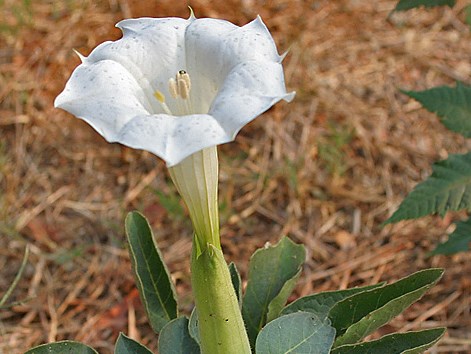Created on: Thursday, Jun 2nd, 2016
The scientific name is often cited as D. innoxia. When English botanist Philip Miller first described the species in 1768, he misspelled the Latin word innoxia (inoffensive) when naming it D. inoxia. The name Datura meteloides was for some time erroneously applied to some members of the species, but that name has now been abandoned.
The following webpages were consulted for this screen: Tropicos: http://www.tropicos.org/Name/29600687; USDA PLANTS: http://plants.usda.gov/core/profile?symbol=DAIN2; ARS GRIN: https://npgsweb.ars-grin.gov/gringlobal/taxonomydetail.aspx?id=13311; GBIF: http://www.gbif.org/species/2928745; CABI: http://www.cabi.org/isc/datasheet/113813; EOL: http://www.eol.org/pages/487967/overviewl; Calflora: http://www.calflora.org/cgi-bin/species_query.cgi?where-calrecnum=9854; LadyBird Johnson: http://www.wildflower.org/plants/result.php?id_plant=DAIN2; Jepson (congener): http://ucjeps.berkeley.edu/eflora/eflora_display.php?tid=22389; Dave’s Garden: http://davesgarden.com/guides/pf/go/355/; Wikipedia: https://en.wikipedia.org/wiki/Datura#Toxicity; CNPLX: http://www.cnplx.info/nplx/species?taxon=Datura+inoxia; PIER: http://www.hear.org/pier/species/datura_inoxia.htm; (congener) http://www.hear.org/pier/wra/australia/datsp-wra.htm; Efloras: http://efloras.org/florataxon.aspx?flora_id=12&taxon_id=200020518; Victoria weeds: http://vro.agriculture.vic.gov.au/dpi/vro/vrosite.nsf/pages/impact_thorn... Australian weeds committee: (congener) http://www.weeds.org.au/cgi-bin/weedident.cgi?tpl=plant.tpl&state=&s=0&i... http://www.weeds.org.au/cgi-bin/weedident.cgi?tpl=plant.tpl&state=&s=0&i... Agriculture Victoria: http://agriculture.vic.gov.au/agriculture/pests-diseases-and-weeds/weeds... CDC: http://www.cdc.gov/mmwr/preview/mmwrhtml/mm5233a2.htm; TrekNature: http://www.treknature.com/gallery/Asia/India/East/West_Bengal/Hooghly/ph... Floridata: http://www.floridata.com/Plants/Solanaceae/Datura%20inoxia%20var.%20quin... Learn 2 Grow: http://www.learn2grow.com/plants/datura/; PFAF: http://www.pfaf.org/user/Plant.aspx?LatinName=Datura+inoxia; UC IPM: http://www.ipm.ucdavis.edu/PMG/WEEDS/jimsonweed.html
Reviewed by Lynn Sweet.
- < 13 : accept (low risk of invasiveness)
- 13 - 15 : evaluate further
- > 15 : reject (high risk of invasiveness)

